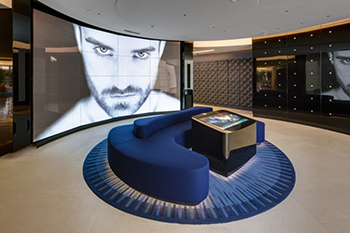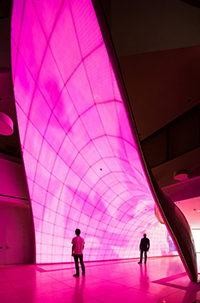 EL SEGUNDO, Calif. — When DirecTV launched a massive renovation project in 2011 for its headquarters in El Segundo, the satellite television provider aimed high to give employees a more sustainable and functional workplace.
EL SEGUNDO, Calif. — When DirecTV launched a massive renovation project in 2011 for its headquarters in El Segundo, the satellite television provider aimed high to give employees a more sustainable and functional workplace.
Renovation details were evaluated and tailored to meet the highest green standards. The effort paid off. The 300,000-square-foot headquarters facility, located within a four-building complex next to Los Angeles International Airport, earned LEED Platinum for Interior Design and Construction (ID+C) in July. The building also holds a LEED Silver rating for the Core and Shell (BD+C) category.
DirecTV’s growth has exploded in recent years. When the company signed a 15-year lease at the El Segundo location three years ago, executives wanted to improve the functionality of its headquarters, which was rapidly moving employees in and putting them wherever they could fit. It wasn’t an ideal situation for productivity and collaboration, according to Hilary Hatch, vice president of real estate and administration for DirecTV.
“We kept growing, and we were not designing offices based on standards. We were just taking space that we got,” Hatch said.
DirecTV initiated a campus-wide renovation with the goal of not only improving employee engagement, but having the headquarters be representative of the company’s sustainability mission. By also reworking the office space layout and design, DirecTV proved renovation — instead of building new — could  actually reduce its footprint. The complex shrank from five buildings to four because the company is now using the space more efficiently, and employees are using a smaller amount of square footage per person. Yet with innovative design features, including natural daylighting and glass offices, the building feels more open than it ever did before. There was even room for a new cafeteria and gym. Moreover, the new aesthetic is helping DirecTV align its brand throughout the company’s complex.
actually reduce its footprint. The complex shrank from five buildings to four because the company is now using the space more efficiently, and employees are using a smaller amount of square footage per person. Yet with innovative design features, including natural daylighting and glass offices, the building feels more open than it ever did before. There was even room for a new cafeteria and gym. Moreover, the new aesthetic is helping DirecTV align its brand throughout the company’s complex.
“We had a vision to change our work environment to design something that reflected our brand and created a more high-energy work environment that enhances collaboration and innovation,” Hatch said.
When it came to reinforcing its commitment to sustainability, DirecTV looked into every aspect of renovation. During the design and construction process, the company turned to Chicago-based JLL, which managed the project and the LEED certification process; Los Angeles-based AECOM, which was the architect and designer; ARC Engineering in Burbank, Calif., which was the mechanical, electrical and plumbing engineer; and Chicago-based Clune Construction, which provided construction services.
Project planners used low-emitting materials in systems, furniture, cleaning supplies, flooring systems, adhesives and sealants, paints and coatings, and other products. They also installed highly efficient mechanical equipment, controls and fresh air exchanges, which allow employees to benefit from a healthier and more comfortable environment. Occupancy sensors have also been installed for 96 percent of connected lighting, and 97 percent of installed equipment and appliances are Energy Star rated. Almost 20 percent of building materials were manufactured using recycled materials, and 46 percent were manufactured within 500 miles of the site.
“The temperature of this building is great. It doesn’t fluctuate like the old buildings did, so you can save money on heating and cooling as well,” Hatch said. “There are also two metro stations that you can walk to, so [the buildings] are close to public transportation, and there are eight electric vehicle charging stations in the garage.”
Major renovations also incorporate a lot of new furniture, which brings up the dilemma of how to dispose of the old. In DirecTV’s case, there was a lot of surplus office furniture — 150 metric tons of it to be exact. To address this, the company worked with ANEW, a nonprofit based in Pasadena, Calif. The organization helped DirecTV distribute its excess furniture to charities, public agencies and underserved communities.
All told, focusing on environmental conservation and sustainability throughout the renovation process helped divert more than 300 metric tons and 96 percent of construction waste away from the landfill.
“The goals [of the renovation project] were really to create a campus instead of just a line of buildings on a street, to reflect our brand and to become a long-term headquarters for our company,” Hatch said. “We wanted to provide a space where employees were excited to work, and we wanted to reduce our environmental impact in a cost-effective manner and increase productivity and performance as well.”

